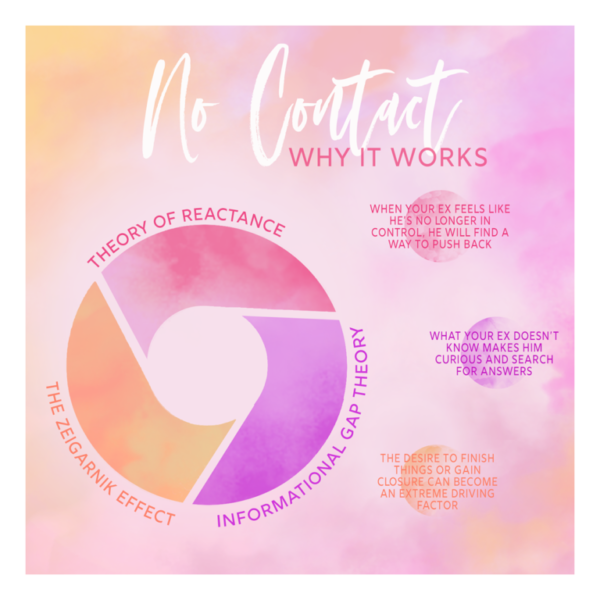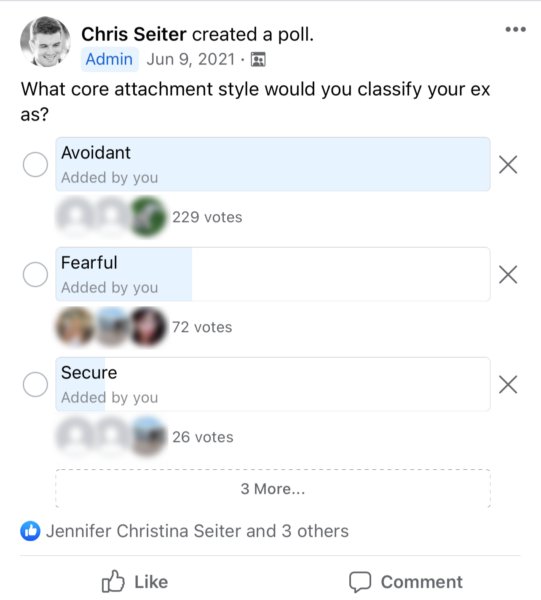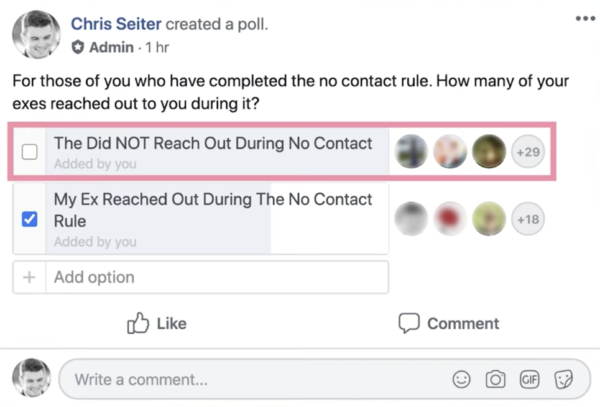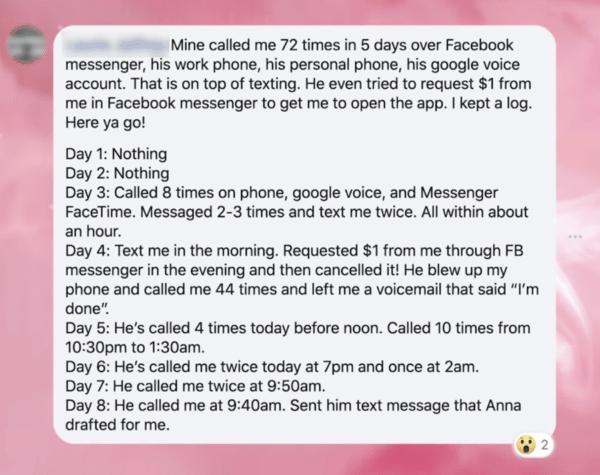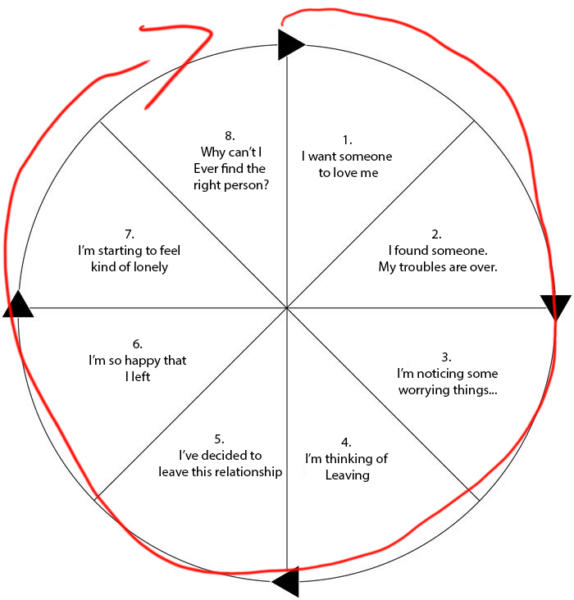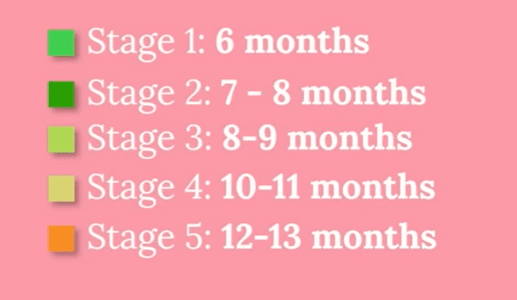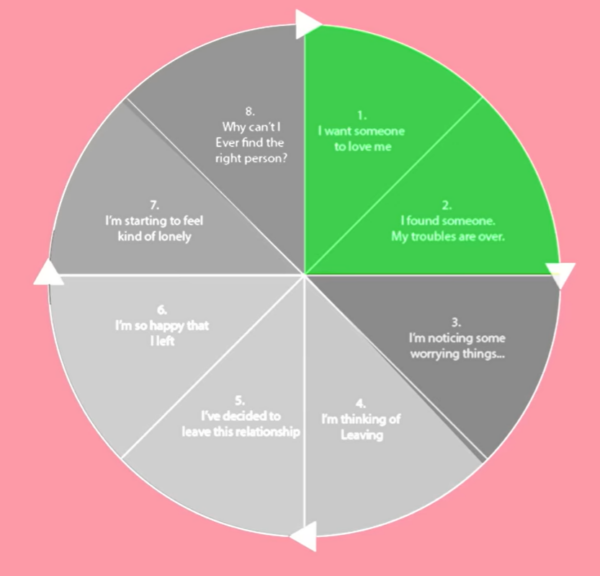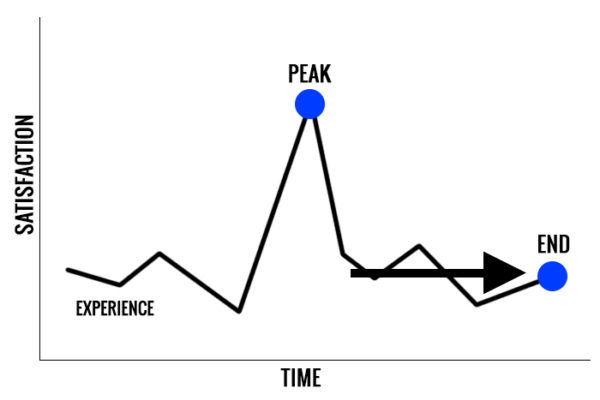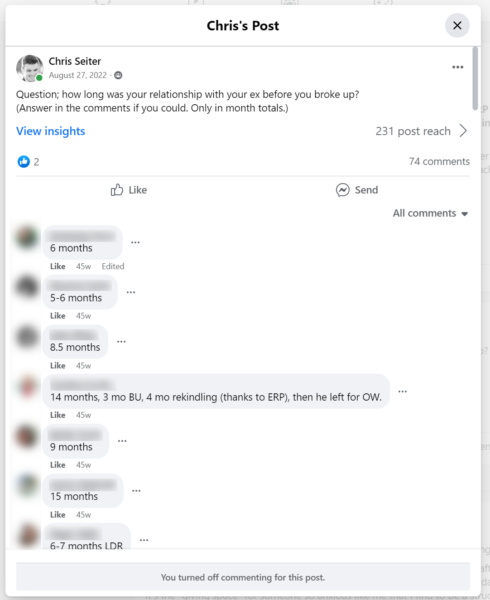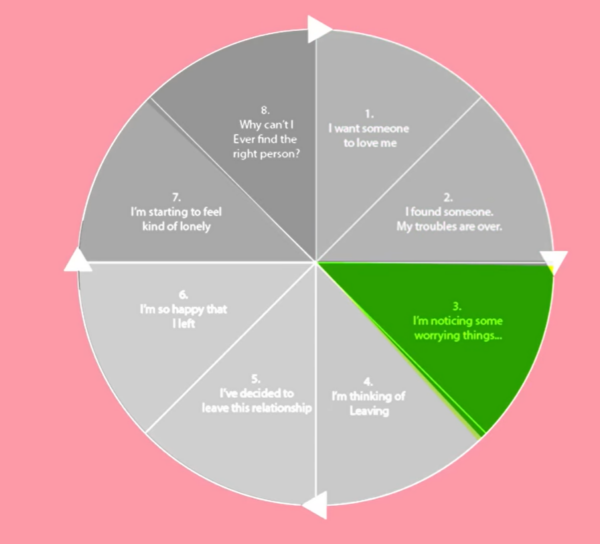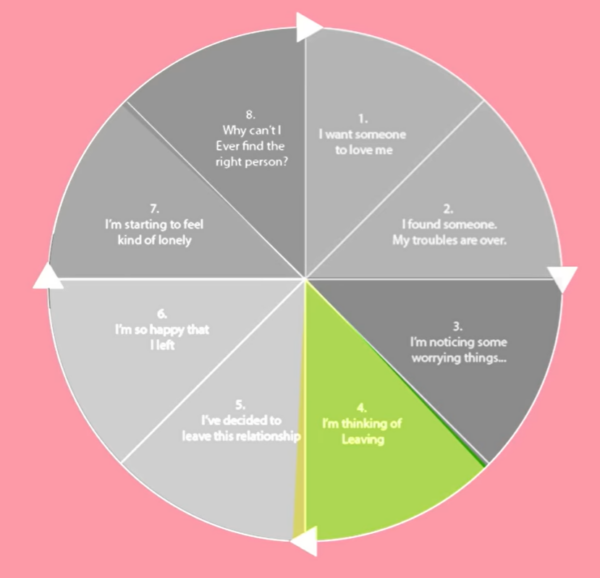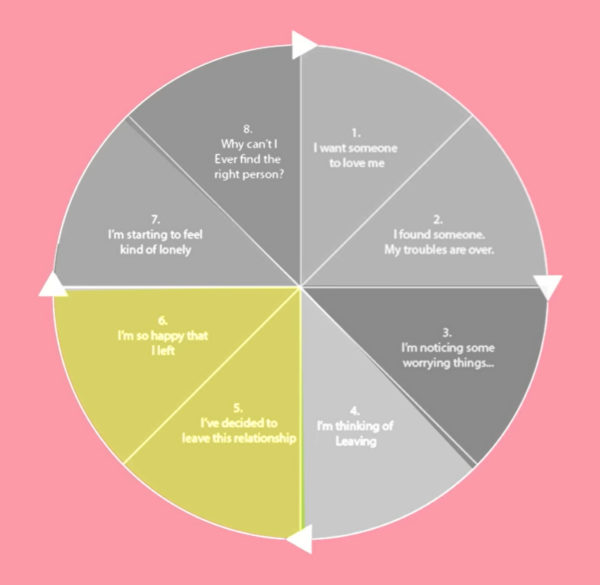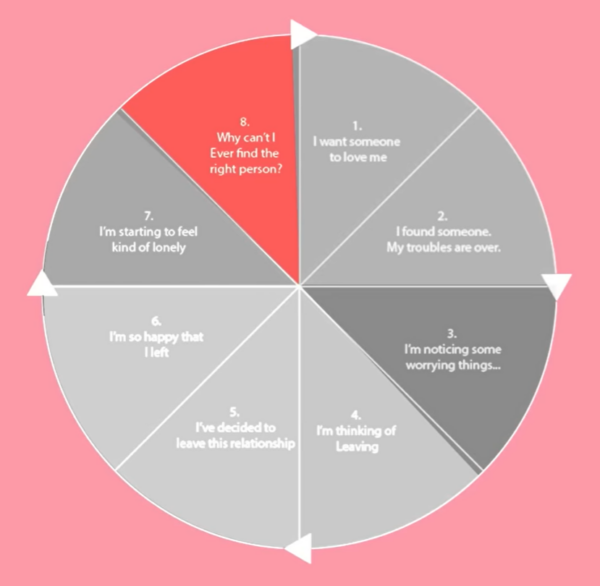I’m going to attempt to do something wild today.
I’m going to pinpoint an exact time frame in which I believe your ex is most likely to miss you during (or even after) a no contact rule.
How am I going to accomplish this you ask?
By merging data from our community, research on attachment styles, reputable studies and pulling from my experience together to create an exact time frame.
But first I feel it’s important to “re-educate you” on what really works to make an ex miss you.

What Are Your Chances of Getting Your Ex Boyfriend Back?
Take the quizThe Importance Of The “Outgrowth Factor”
So, many times, specifically when you’re trying to figure out how long it will take for an ex to miss you without contact—meaning you’re implementing a no contact rule—the natural assumption is that by doing ignoring your ex they will be more likely to miss you.
I’ve even been guilty of propagating information on the psychological components of the no contact rule that suggest this could be the case.
Yet, what I’ve found is that that the psychological components are more likely to make an anxious ex miss you, as opposed to an avoidant ex.
As I’m so fond of mentioning in every video, podcast, and article, over 65% of our clients believe their exes are avoidant.
What I’ve noticed is that the question we’re posing here in this discussion is, in itself, a trap.
I’ve observed that exes usually don’t start missing you until you’ve outgrown them.
Notice how I use the term ‘outgrow them’ and not ‘move on from them.’
This is a conscious choice because ‘moving on’ implies you have no desire to get your ex back, and many of the people who seek our advice strongly desire to reunite with their exes. But also, ‘moving on’ can imply that you’ve shifted your affections to someone else.
So, in essence, ‘moving on’ is about recovery and readjustment after the end of a relationship, whereas ‘outgrowing’ is about personal development and change that can make you realize your own worth.
If you refer to my official definition of the no contact rule here,
The no contact rule refers to a period of time where you cut off all conceivable communication with an ex after a breakup. The intent of this tactic should NOT be used to make your ex miss you but instead should be used to rebuild your own life so that you outgrow your ex. By doing this, the no contact rule can have the added benefit of making an ex miss you.
You’ll see that we’ve woven this ‘outgrowing’ function into it, and even highlighted the fact that if you’re implementing the no contact rule solely to make an ex miss you, you’re doing it for the wrong reasons.
There’s a cause and effect to it.
The Average Ex Will Not Contact You During A No Contact
Usually, from the exes we’ve observed, you implement the no contact rule, you work on outgrowing your ex, and then as a symptom of you outgrowing your ex, they start to miss you.
This is actually backed up by further research we’ve done.
A few years ago, we conducted a poll where I asked the people in our community, “Hey, for those of you who have completed a no contact rule, how often have exes actually reached out to you during it?”
We found that close to 62% of individuals said their exes did not reach out to them at all during the no contact rule.

What Are Your Chances of Getting Your Ex Boyfriend Back?
Take the quizSo, this theory out there that the no contact rule is likely to prompt your ex to have some sort of strong response like this,
Is very often the exception to the rule.
And if you understand anything about attachment styles, you would realize that this makes a lot of sense.
Someone with an avoidant attachment style is not likely to reach out to you directly.
This is also why I often have to argue with my female clients about the fact that they’re probably going to have to reach out to their ex first if they want their ex back. I can certainly understand their position, but I also understand the ex’s position, so I’m trying to bridge the gap between them.
If we operate under the assumption that the ex you’re trying to make miss you by using some form of no contact, we can understand and potentially pinpoint exactly when they will start to miss you by using our knowledge of avoidance.
Using The Avoidant Death Wheel To Create A Time Frame
So, I’m really famous for creating this graphic called the “Avoidant Death Wheel.”
Of which there are eight main phases:
- I want someone to love me
- I found someone my troubles are over
- Hey, there’s some worrying things I’ve noticed
- I’m thinking of leaving this relationship
- I actually left this relationship
- I’m so happy that I actually left
- I’m starting to feel lonely
- Why can’t I ever find the right person?
But here’s the cool part: we have actually gone as far as color-coding these eight stages and dividing them up into five specific categories or stages, if you will.
And I created this legend to help you understand how long on average each stage is going to last.
By using this, we can pinpoint exactly where we see exes start to feel like they begin to miss you. So, what I’d like to do next is go through it.
Stage One: Honeymoon Stage (An Avoidants Paradise)
So, stage one is also called the honeymoon stage, and I’m going to add a little extra thing there and say it’s an “avoidant’s paradise.”
So, stage one, we’ve color-coded as green and it comprises the first two phases of the avoidant death wheel.
- The “I want someone to love me” phase
- “I found someone, my troubles are over” phase.
Now, how long does it typically last?
Well, this is kind of an interesting debate.
The first thing that I wanted to address was that, obviously, this phase lasts as long as the honeymoon period lasts. Right? But there’s a lot of debate out there about how long the honeymoon period lasts.
A simple Google search will tell you that it can last anywhere from six months to two years.
Which one is relevant for us?
So, I had to do a lot of digging until I finally found this study,
Which basically argued that it lasted up to 30 months.
But something about it was bugging me. And I think the context is the most important thing that is often overlooked when you’re looking at large studies like this.

What Are Your Chances of Getting Your Ex Boyfriend Back?
Take the quizThe large study isn’t specifically studying breakups; they’re studying the honeymoon period and how long it lasts.
But the thing that was bugging me is I felt in my gut that our average client does not have a honeymoon period that lasts that long.
I mean, typically, once the honeymoon period ends and a breakup occurs, there’s almost like a decline. Like if you were able to chart it, you would notice there’s a downhill trajectory on the satisfaction of the relationship from that moment on.
So, I started going through our community and found that last year, I had a similar thought. I literally polled the community and asked, “Hey, how long was your relationship with your ex before you broke up?” And I had them answer in the comments.
And then I actually started pulling the comments and found:
That our average client base tends to have a relationship only lasting around nine months before the breakup occurs.
So this implies that the honeymoon period for them is not going to last 30 months.
And I think this is why context is so key.
For them, I think it’s much more likely to last shorter, something like six months.
And this also makes sense. Typically speaking, when you’re only studying breakups, you’re studying relationships that have problems, that need to be worked through. And so these relationships are not going to be necessarily the most stable ones that you’re looking at.
Now, it’s also important to remember, this is an average.
So, ultimately, I guess what I’m trying to say is, I believe the first two phases of the avoidant death wheel are going to last six months. So you’re going to spend six months in this blissful period. And for an avoidant specifically, this is the ideal scenario.
An avoidant wants a honeymoon period to last as long as possible, because there’s no threat of a greater commitment.
Stage 2: The Anxious Triggering Stage
But often, things start to turn when you enter into stage two, which I call the “anxious triggering stage.”
I’m going to color-code this as a darker green.
Usually, you’re going to find that this happens between around months seven and eight.
You’ll notice that we’re getting kind of close to that nine-month breakup mark.
But what is this stage, though?
This stage includes anything that you’re doing that triggers the avoidant’s avoidance side to actually go off. Sometimes this can be talking about taking the next step in the relationship now that the honeymoon period is over.
They’re not as likely to want to daydream about that.

What Are Your Chances of Getting Your Ex Boyfriend Back?
Take the quizMost of the time, we’ve noticed that the ultimate pairing that we’re dealing with is our clients, who tend to be very anxious, and their exes, who tend to be very avoidant.
So we have this anxious and avoidant connection.
A lot of the anxiety kind of bubbling up to the surface causes the avoidant to freak out and want to move away or start to find a way to avoid. And thus, you have the “anxious triggering stage,” which leads to stage three, the “breakup contemplation stage.”
Stage 3: The Breakup Contemplation Stage
Now, this stage is usually going to happen around months eight and nine, and I’ve color-coded this into a nice, in-between yellow-green hue.
Essentially, right after the “anxious triggering stage.”
For about a month, the avoidant will contemplate leaving.
It’s interesting because an avoidant often avoids conflict, right? So they know that talking to you about potentially breaking up is going to trigger you negatively.
As a result, they often put it off, and what you’ll start noticing during this “breakup contemplation stage” is they become very distant.
I’m sure we’ve all been in a relationship where we’ve sensed that something is off with the other person, something they’re not telling us.
We’re very worried about that.
Well, that’s usually going to be the “breakup contemplation stage.”
Stage 4: The Separation Elation Stage
This leads to stage four, which is the “separation elation stage.”
This typically occurs around months 10 or 11.
The “separation elation stage” comprises two distinct phases of the avoidant death wheel:
- The “I’ve decided to leave this relationship” phase
- “I’m so happy that I left” phase.
The thing you need to understand about avoidants is usually when they break up with you, they don’t grieve — they rejoice.
And there’s a clear reason for that.
The avoidant’s core wound is always revolving around a loss of independence. So the fact that they’ve broken up with you and regained their independence, they feel great about it.
Ironically, it is during this stage that the no contact rule often goes into effect.
So you’ve gone through a breakup, you start searching the internet for advice, or maybe just naturally, you implement this no contact rule with your ex. This also supports the idea that this is why your ex is usually not going to reach out to you during the no contact rule, as statistics show.
It’s because they’re smack dab in the middle of that “separation elation” period.
The big mistake people tend to make is they try to over-pursue or beg during the “separation elation” stage.
This is not the time to beg. They’re usually not going to miss you during this stage. They are just happy to have their independence back. But here’s the good news: this stage ultimately wears off.
One of the reasons why I am a huge fan of longer periods of no contact is it gives them a little bit more runway for that “separation elation” phase to wear off and transition to the fifth and final stage, the “loneliness and grief redirection stage.
Stage #5: Loneliness/Grief Redirection Stage
This usually occurs around months 12 and 13.
So here we have the “separation elation” stage wearing off and giving way to stages seven and eight of the death wheel, the “I’m starting to feel kind of lonely” and the “Why can’t I ever find the right person?” stages.
This is when your ex is most likely to start missing you.
If you’ve been able to outgrow your ex, if you’ve been able to implement what I suggest during the no contact rule — extending it out, having a longer period, and outgrowing your ex during it — then that allows them to process the breakup in a way that can trigger nostalgic reverie.
I talk a lot about this, but I made a video a couple of years ago,
Where I said that to make an avoidant miss you, the key is to have them see you not as a threat of trying to get them back, but as if you’ve moved on or outgrown them.
And if you do that, the avoidant gives themselves permission to miss you because now there’s no threat of an overarching commitment down the line.
This is why your ex is most likely to actually start missing you towards the end or at the beginning of this transitional period between the “separation elation” stage and the “grief redirection” stage.
Now, why do I say “grief redirection”?
Because avoidants are caught in this death wheel.
So, as they go into this “loneliness and grieving” stage, they seek to find a distraction. Either that distraction is jumping into a rebound relationship with someone else, or going back to you, or immersing themselves into some sort of job and swearing off relationships altogether for a little while.
So typically, your ex won’t start missing you until around two to three whole months after the breakup. And as I mentioned earlier, it only really works if you’ve shown that you’ve outgrown your ex.
But it’s also important to remember that everything I’m saying here are estimates. They’re averages based on a lot of data, and the actual figures can vary widely.
If you look at the attachment above showing how long relationships typically last for our clients, you’ll see that the shortest one lasted, at least in the screenshot that I provided, five months, whereas the longest one lasted 14 months.
That’s a huge range. So everyone’s going to have a unique experience with this, and we’re only looking at averages.
While it’s true that we think the two to three-month post-breakup mark is around the time when an ex can start to miss you, many factors go into making an ex miss you. And if you skip any one of them, it can derail the whole process. Just to give you an idea of the timeframe, that’s what it is.
